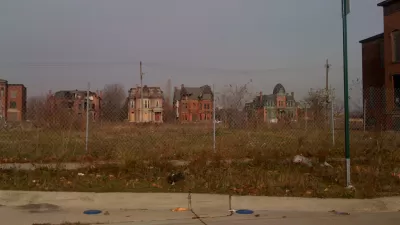Jason Segedy has published a long, brutally frank look at blight and vacant properties, especially at the underappreciated culprit for the woes of so many shrinking cities around the Rust Belt: household decline.

Segedy begins the long article (originally published on Notes from the Underground and later picked up by Rustwire) by asking the question of "why is widespread vacancy and a glut of abandoned property a relatively recent phenomenon, while population loss is not?"
The proliferation of vacancies and blight during the 21st century is the result of demographic trends taking place over 50 years independently from the planning decisions of many cities. In fact, Segedy suggests we "[forget], for a minute, the usual suspects in urban decline, such as “white flight”, larger suburban houses and yards, highway construction, increasing automobile usage, crime, declining schools, etc." and focus on demographic trends like rising divorce rates, rising age of first marriage, rising life expectancy, and declining birth rates, which occurred all at the same time.
Here's how Segedy then sums up the impact of shrinking household: "The role of shrinking household size in urban population loss may be the most under-reported story about urban decline of the entire 20th century."
And it follows: "Urban population decline in the 20th Century, was, in many ways, an unavoidable demographic reality that could only have been mitigated by rezoning and building at even higher densities – a housing trend that would have been running exactly counter to the prevailing market wisdom at the time."
Segedy goes on to provide a detailed and lengthy examination of the housing stock of many Rust Belt cities. Built at low quality between the 1920s and 1960 for industrial workers, the housing stock of cities like Youngstown, Ohio quickly became obsolete and hard to maintain. "All we really know for sure is that there was a lack of demand for most of the product currently on the urban housing market – namely older houses with high front-end renovation costs, significant ongoing maintenance and upkeep costs, and many obsolete features – not enough closets, not enough electrical outlets, small kitchens and bathrooms, no garage, etc.," writes Segedy.
The article concludes with a case study of these dynamics and concepts as applied to the example of Akron, Ohio, where the city tears down an average of 500 houses every year while building an average of ten. Segedy also makes policy remarks obviously directed toward cities like Buffalo and Detroit, which are focusing on things like new stadiums, casinos, or convention centers rather than the only real balm for their decline: new housing.
FULL STORY: What’s in a Number? Confronting Urban Population Decline

Maui's Vacation Rental Debate Turns Ugly
Verbal attacks, misinformation campaigns and fistfights plague a high-stakes debate to convert thousands of vacation rentals into long-term housing.

Planetizen Federal Action Tracker
A weekly monitor of how Trump’s orders and actions are impacting planners and planning in America.

San Francisco Suspends Traffic Calming Amidst Record Deaths
Citing “a challenging fiscal landscape,” the city will cease the program on the heels of 42 traffic deaths, including 24 pedestrians.

Detroit Says Problems With Property Tax Assessments are Fixed. Advocates Disagree.
With higher-valued properties under assessed and lower-valued properties over assessed, advocates say there's still a problem with Detroit's property tax system.

Defunct Pittsburgh Power Plant to Become Residential Tower
A decommissioned steam heat plant will be redeveloped into almost 100 affordable housing units.

Trump Prompts Restructuring of Transportation Research Board in “Unprecedented Overreach”
The TRB has eliminated more than half of its committees including those focused on climate, equity, and cities.
Urban Design for Planners 1: Software Tools
This six-course series explores essential urban design concepts using open source software and equips planners with the tools they need to participate fully in the urban design process.
Planning for Universal Design
Learn the tools for implementing Universal Design in planning regulations.
Heyer Gruel & Associates PA
JM Goldson LLC
Custer County Colorado
City of Camden Redevelopment Agency
City of Astoria
Transportation Research & Education Center (TREC) at Portland State University
Jefferson Parish Government
Camden Redevelopment Agency
City of Claremont





























